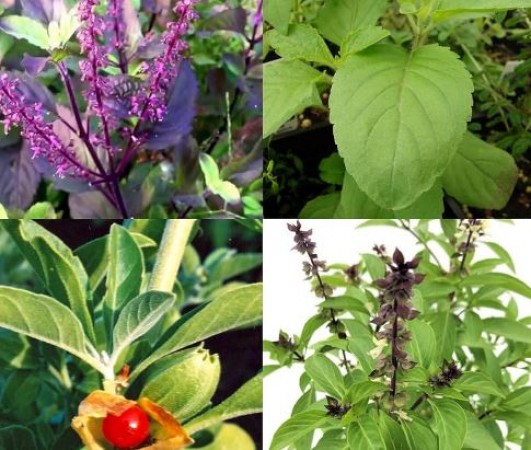
In Hinduism, the Tulsi plant holds immense importance, believed to bring positive energy and dispel negativity from homes. Widely found in temples and households, Tulsi is not just a symbol of spirituality but also a source of medicinal benefits. Every year, the auspicious occasion of Kartik Ekadashi witnesses the celebration of Tulsi Vivah, with this year's ceremony scheduled for November 24th.
According to religious scriptures, Tulsi is considered a symbol of positivity. However, beyond its spiritual significance, Tulsi has been utilized for centuries in Ayurveda for its medicinal properties. The leaves of Tulsi find application in numerous home remedies. Let's delve into the various types of Tulsi that exist:
Shyama Tulsi (Purple Basil):
Shyama Tulsi, also known as Purple Basil, is a distinct variety of Tulsi characterized by its vibrant purple leaves. This particular type of Tulsi is often associated with spiritual significance and finds its roots in Hindu traditions. Beyond its cultural importance, Shyama Tulsi holds notable health benefits.
The leaves of Shyama Tulsi are rich in antioxidants and essential oils, contributing to its anti-inflammatory and antimicrobial properties. In Ayurveda, Shyama Tulsi is commonly used to alleviate respiratory issues such as coughs and throat infections. The purple color is indicative of anthocyanins, which are known for their potential health-promoting properties.
Cultivation of Shyama Tulsi is widespread in regions with a tropical climate. The plant requires well-drained soil and sunlight for optimal growth. Its adaptability to various climates makes it a popular choice not only in India but also in other parts of the world.
Rama Tulsi (Green Basil):
Rama Tulsi, or Green Basil, is a prevalent type of Tulsi found in households across Bengal, Bihar, China, and Brazil. The distinctive green leaves set it apart from other varieties. Rama Tulsi is revered not only for its spiritual significance but also for its versatile medicinal applications.
Known for its cooling properties, Rama Tulsi is often used to soothe respiratory ailments such as cough and bronchitis. The leaves have a milder taste compared to other types of Tulsi, making them suitable for various culinary uses. Additionally, Rama Tulsi is believed to have adaptogenic properties, helping the body cope with stress.
Cultivation of Rama Tulsi is relatively straightforward, requiring well-drained soil and adequate sunlight. The adaptability of this Tulsi variety makes it a staple in both traditional medicine and daily life.
Vana Tulsi (Wild Basil):
Vana Tulsi, also known as Wild Basil, is a unique variety found in northern parts of India, Sri Lanka, Java, and Africa. It differs significantly from Rama and Shyama Tulsi, both in appearance and properties. Vana Tulsi is recognized for its anti-aging elements and diverse medicinal applications.
In Ayurveda, Vana Tulsi is utilized for its ability to address various health concerns. It is often included in herbal remedies for its potential to boost immunity and promote overall well-being. The leaves of Vana Tulsi have a robust aroma, and the plant itself is hardy, thriving in a variety of climates.
Cultivating Vana Tulsi requires attention to soil quality and adequate sunlight. Its adaptability to different regions makes it a valuable addition to traditional medicine practices worldwide.
Kapoor Tulsi (Camphor Basil):
Kapoor Tulsi, commonly known as Camphor Basil, derives its name from the camphor-like aroma released when its leaves are crushed. This variety of Tulsi is recognized not only for its spiritual significance but also for its distinctive fragrance and medicinal properties.
The leaves of Kapoor Tulsi contain compounds that contribute to its unique scent, making it a popular choice for aromatic purposes. Medicinally, Kapoor Tulsi is utilized for its potential in treating malaria, diarrhea, bronchitis, and various skin issues. Its antimicrobial properties make it a valuable ingredient in natural remedies.
Cultivating Kapoor Tulsi requires attention to soil drainage and exposure to sunlight. The aromatic qualities of this Tulsi variety make it a sought-after addition to gardens and households, contributing to both spiritual practices and holistic well-being.
The diverse types of Tulsi reflect the plant's adaptability to different regions and climates. With a height often exceeding three feet, Tulsi holds cultural and medicinal significance. As we celebrate Tulsi Vivah this Kartik Ekadashi, let's appreciate not only the spiritual aspects but also the health benefits that this sacred plant brings to our lives.
In conclusion, Tulsi, in its various forms, has been an integral part of Hindu culture and traditional medicine for centuries. Its presence in homes and temples not only symbolizes spirituality but also serves as a natural remedy for a range of health issues. As we continue to embrace Tulsi in our lives, let us acknowledge the rich tapestry of cultural and healing traditions woven around this revered plant.
Are You Struggling with Sleep Deprivation? Try Adding These Foods to Your Diet for Better Sleep
The Healing Power of Warm Water: Ayurvedic Secrets of Hot Water
Eggs And Diabetes: Breaking Myths, Embracing Health, Know These Things